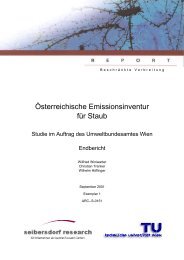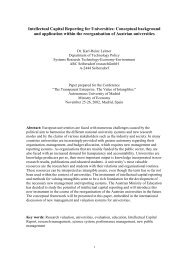ALPMON FINAL REPORT - ARC systems research
ALPMON FINAL REPORT - ARC systems research
ALPMON FINAL REPORT - ARC systems research
Create successful ePaper yourself
Turn your PDF publications into a flip-book with our unique Google optimized e-Paper software.
Contract ENV4-CT96-0359 <strong>ALPMON</strong><br />
can be improved significantly. The SPOT 4 sensor delivers images with 20m resolution in the multispectral<br />
bands and 10m resolution in the panchromatic band. Furthermore, the middle infra-red<br />
spectrum has been added, compared to the former SPOT sensors. The combination of the higher<br />
resolution and the availability of a middle infra-red band proves to be a big advantage with respect to<br />
the classification of alpine vegetation parameters. SPOT 4 data are available on request since 1999. It<br />
is strongly recommended to use these data instead of Landsat TM images for a detailed investigation<br />
of forest parameters as well as other Alpine vegetation with respect to the parameters required for<br />
avalanche risk models.<br />
Some constraints have to be mentioned concerning two non forest land cover categories. The<br />
requirement of the customer to separate different types of grassland with respect to their use could not<br />
be fulfilled with the available satellite data. The only separation could be made between rich and poor<br />
grassland, which in most cases is related to the meadows in the valleys vs. the alpine pastures above<br />
the forest border line. Furthermore, the rock size could not be classified with these data. This might<br />
become possible with the high resolution sensors, having in mind texture features and the amount of<br />
shadow within a pixel.<br />
In general it can be stated, that areas outside the forest can be classified due to their spectral variation<br />
if they occur on large areas. Smaller areas, which are covered by a mixture of vegetation categories,<br />
such as rhododendron, dwarf mountain pine or smaller moor areas that do not exceed 1 ha, cannot be<br />
classified definitely because of the mixed pixel problem. Simulations have proved that a geometric<br />
resolution of about 5 to 10m in the infrared spectral range is necessary to assess the typical small-area<br />
distribution pattern of vegetation outside of forests. The future sensor <strong>systems</strong> will provide data in this<br />
resolution range.<br />
Other decisive criteria related to the morphology (slope, aspect, curvature, and flow length) could be<br />
derived from a digital elevation model. However, the currently available DEM resolution (25m) is too<br />
rough to detect morphological surface characteristics, that might affect avalanche release, such as<br />
shape of slope (convex/concave) and length of slope in non forested areas or areas with critical forest<br />
canopy density, in sufficient detail. Here, high resolution laser scanner models could deliver valuable<br />
information. But due to the high costs for these data the information should be restricted to the areas<br />
that have been defined as (very) critical in the first steps an hierarchical risk assessment, including the<br />
aspect of vulnerability.<br />
The time resolution is another crucial factor for information extraction. A yearly update in general<br />
seems to be possible with the currently available satellite <strong>systems</strong>. The bottleneck might be the<br />
availability of images from winter with the specific snow situation required. On the other hand, the<br />
distribution of dwarf mountain pine and greenalder shows no extensive variations. Therefore, an<br />
update of this information within a 5 years period seems to be sufficient and practicable.<br />
Finally, it should be taken into consideration that satellite image classification in general could also be<br />
used as a tool for updating the information on infrastructure that is exposed to avalanche damage,<br />
implemented in a GIS.<br />
2.3.4 Erosion Risk Assessment, Cordevole Test Site (RSDE)<br />
2.3.4.1 Introduction and Objectives<br />
The assessment of erosion risk is a primary problem in mountainous regions. The purpose of this<br />
feasibility study was to develop a proper methodology for the production of erosion risk maps in these<br />
regions exploiting information derived from remote sensing technology.<br />
The review of the existing studies on soil erosion indicates that current basic methodologies have been<br />
established primarily to assess soil erosion risk over agricultural and hilly areas in temperate climate.<br />
These methodologies therefore cannot be directly applied to a much more complex system, such as<br />
the alpine environment. Further, the use of a single methodology could hardly account for all the<br />
features of the alpine erosion phenomena. In fact, besides common erosion processes, other relevant<br />
processes increase the transformation rate of the alpine landscape. The most widespread erosion<br />
models like USLE/RUSLE or CORINE EROSION cannot be successfully applied to the alpine areas<br />
because they have been conceived to work on hilly terrain for agricultural purposes where sheet and rill<br />
erosion processes are prevailing. Mass erosion processes typical of alpine environment like debris<br />
flows are not taken into account in these models. Further, CORINE EROSION is not considered a<br />
suitable model for regional planning applications at scale 1:25.000 as required by the customer.<br />
JR, RSDE, ALU, LMU, Seibersdorf, WSL 43




